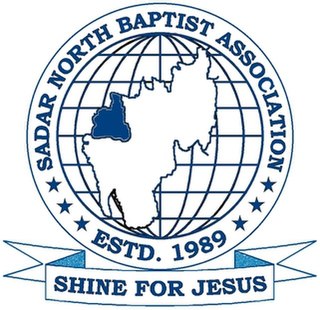
Agartala is the capital and the largest city of the Indian state of Tripura, situated on the banks of Hoara River, about 2 kilometres (1.2 mi) east of the border with Bangladesh and about 2,499 km (1,52 mi) from the National Capital New Delhi. According to 2022 census, Agartala is the third-most populous city in Northeast India with a population of about 5.7 lakh. It is India's third international internet gateway and being developed under the Smart Cities Mission.

The Tripura Baptist Christian Union (TBCU) is a Baptist Christian denomination in Tripura, India. It has its head office in Agartala, the state capital. The TBCU is affiliated to the Asia Pacific Baptist Federation (APBF) and the Baptist World Alliance (BWA). It is also a member church in the North East India Christian Council (NEICC), a regional church body of the National Council of Churches in India (NCCI). As of 2020, TBCU had 84,795 members in 943 churches.
Khumulwng is a town in the West Tripura district in the Indian state of Tripura. It is the headquarters and the largest town of the Tripura Tribal Areas Autonomous District Council.

Sadar North Baptist Association (SNBA) is a Baptist Christian denomination in Tripura. It is located within the West Tripura district of Tripura in India. As of 2014, SNBA had more than 21,000 members and 156 churches.
Protestants in India are a minority and a sub-section of Christians in India and also to a certain extent the Christians in Pakistan before the Partition of India, that adhere to some or all of the doctrines of Protestantism. Protestants in India are a small minority in a predominantly Hindu majority country, but form majorities in the north-eastern states of Meghalaya, Mizoram& Nagaland and significant minorities in Konkan division, Bengal, Kerala& Tamil Nadu, with various communities in east coast and northern states. Protestants today trace their heritage back to the Protestant reformation of the 16th century.

Christianity is a minority religion in Sri Lanka. It was introduced to the island in first century. Traditionally, after Thomas the Apostle's visit in Kerala in AD 52, Christianity is said to have been introduced to Sri Lanka because of its close geographical and commercial ties.
The Diocese of Agartala is a Catholic diocese comprising the entire State of Tripura in the Ecclesiastical province of Shillong in India. The cathedral is St. Francis Xavier Cathedral in Agartala.
Agartala City Baptist Church is a Baptist Church in the city of Agartala, the capital of Tripura state in India. It is affiliated to the Tripura Baptist Christian Union (TBCU) and is located in Krishnanagar locality in the central part of Agartala city.

Christianity is a third largest religion in Assam, a state of India in the north-eastern region. The population of Christians in Assam is 1,165,867 making up 3.74% of state population as of the 2011 census report, and it is also the second-fastest growing religion in Assam after Islam. The largest concentration of Christians in Assam can be found in Dima Hasao District where Christian population is about 30% and Karbi Anglong district where Christian population is about 16.5% as of the 2011 census report.
Christianity is the second most followed religion in Manipur, a state in Northeast India, according to 2011 census data of India.
Christianity is the largest religion in the Northeastern Indian state of Arunachal Pradesh, which borders China. According to the census of 2011 Christians constitute 30.26% of the state's population. The Roman Catholic Church is the largest Christian denomination in the state with around 180,000 adherents. The Arunachal Baptist Church Council is the second largest denomination with 150,000 baptized members in about 1,200 churches and Arunachal Pradesh Christian Revival Church Council (APCRCC) which started in 1987 at Naharlagun also growing fast.
The predominant religion of Nagaland is Christianity. The state's population is 1,978,502, as of 2011, out of which 87.93% are Christians. The 2011 census recorded the state's Christian population at 1,745,181, making it, with Meghalaya, Arunachal Pradesh, and Mizoram as the four Christian-majority states in India. The state has a very high church attendance rate in both urban and rural areas. Huge churches dominate the skylines of Kohima, Chümoukedima, Dimapur and Mokokchung.
Evangelization of indigenous population to Christianity began in the 19th century under the British era. In the 1830s, American Baptist Foreign Missionary Society had become active in Northeast to evangelize indigenous tribes to Christianity. Later, they were offered to expand and reach into Sohra Meghalaya, but they lacked the resources to do so and declined. Welsh Presbyterian Mission took the offer and they began work at Sohra mission field. By the early 1900s, other Protestant denominations of Christianity were active in Meghalaya. The outbreak of World Wars forced the preachers to return home to Europe and America. It is during this period that Catholicism took root in Meghalaya and neighbouring region. Currently, Catholics, Presbyterians and Baptists are three most common Christian denominations found in Meghalaya.

Christianity is the largest religion in Mizoram. The majority 87% of Mizoram population are Christian in various denominations, predominantly Presbyterian. More than 98% of the Mizos are Christians by faith. The Government of Mizoram declared that Christianity plays a very important role among the daily life of Mizo community and therefore further declared that Christianity as the religion of the state. The culture of Mizoram is mainly influenced by Christianity. Hence, Christianity was given a special status on the state by the government while maintaining a minimum level of secular environment & approach. In June 2018, the government of Mizoram including Vanlalruata, president of anti-corruption organisation-turned-political party, People's Representation for Identity and Status of Mizoram claim that Mizoram is a Christian state. Hindus form a small minority (3.55%) mainly of Manipuris and there are also around (7.93%) Buddhists according to the 2001 census, mostly made up from Chakma settlers of Arakan origin. There are about 8,000 mostly ethnic Mizo followers of a Judaic group Bnei Menashe, who claim descent from the biblical Menasseh. Muslims make up about 1.1% of the state population.
KOK Baptist Association (KOKBA) is a Kokborok speaking Baptist community in Tripura. It is located within the Khowai district of Tripura in India. It has around 3,800 communicant members in 60 churches.

The history of Christianity in Mizoram covers the origin and development of all forms of Christianity in Mizoram since the British occupation at the end of the 19th century. Christianity arrived as a consequence of tribal warfare, raids of British plantations, and the ensuing punitive British military expedition called the Lushai Expedition of 1871. The subsequent annexation of the erstwhile Lushai Hills to the British Empire opened the gateway for British Christian missions to evangelise the Mizo people.
The Tripura Presbyterian Church Synod is one of the constituent units of the Presbyterian Church of India. It has its headquarters in Agartala, Tripura. It has 325 churches and 22,277 members mostly among the indigenous peoples of Tripura.






